Netki CEO: Why do I think Len Sassaman is Satoshi Nakamoto?
HBO documentary reignites speculation that Len Sassaman is the creator of Bitcoin. I know Len. This theory makes sense.
 JinseFinance
JinseFinance
Note: During the 2024 Chinese National Day holiday, a piece of news has attracted the attention of the crypto community. HBO will broadcast the documentary "Money Electric: The Bitcoin Mystery" on October 8, which is said to reveal who is the founder of Bitcoin, Satoshi Nakamoto.
In the Polymarket market where people in the crypto industry are active, 34% of people believe that the Satoshi Nakamoto revealed by the HBO documentary is Len Sassaman, which is much higher than Hal Finney, Blockstream CEO Adam Back and Nick Szabo, the father of smart contracts, who are more famous in the industry.
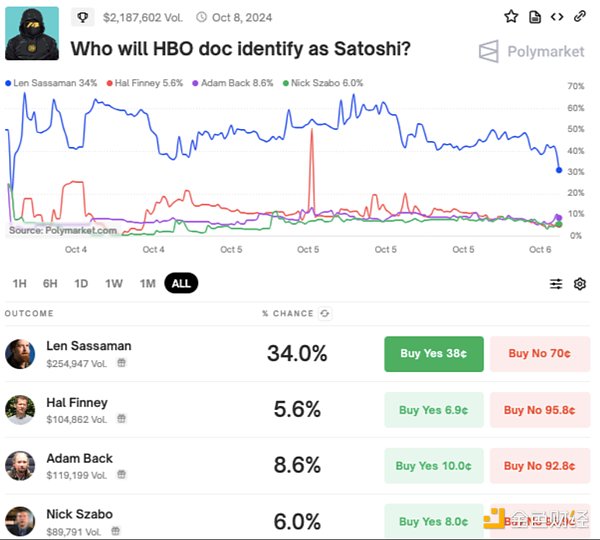
So who is Len Sassaman? Why do people think Len Sassaman is most likely to be Satoshi Nakamoto? Evan Hatch, founder of Worlds.org, published an article in 2021 introducing Len Sassaman's life information and the similarities between Len Sassaman and Satoshi Nakamoto. He believes that Len Sassaman is likely to be Satoshi Nakamoto, a direct contributor to Bitcoin.
The original title is "Len Sassaman and Satoshi: a Cypherpunk History". Golden Finance compiled this article to reward readers.
We have lost too many hackers who committed suicide. What if Satoshi Nakamoto was one of them?
An obituary is embedded in every node of the Bitcoin network. It was embedded in the transaction data to honor Len Sassaman, who has essentially been immortalized in the blockchain. In many ways, it was a fitting tribute.

Block 138725
Len was a true cypherpunk—brilliant, irreverent, and idealistic. He dedicated his life to defending individual freedom through cryptography, working as a developer of PGP encryption and open source privacy technology, and as an academic cryptographer studying P2P networks under the guidance of blockchain inventor David Chaum.
He was also a pillar of the hacker community: a friend and influencer of many important figures in the history of information security and cryptocurrency.
It was said that Len was on track to become one of the most important cryptographers of his time. But after a long battle with depression and functional neurological disorders, he tragically committed suicide on July 3, 2011, at the age of 31.
His death coincided with the disappearance of the world's most famous cypherpunk: Satoshi Nakamoto. Just 2 months before Len's death, Satoshi sent his final communication:
I have moved on to other things and may not be here in the future.
Over the course of a year, Satoshi Nakamoto committed 169 code and published 539 posts, then disappeared without explanation. He left behind a mountain of unfinished features, heated debates about his vision for Bitcoin, and a $64 billion BTC fortune that remains untapped to this day.
We’ve lost too many hackers to suicide. Aaron Swartz, Gene Kan, Ilya Zhitomirskiy, James Dolan. They are all victims, and of an epidemic that has cost technological progress itself. Imagine if Bitcoin’s creator had achieved his goal before he died. If that were true, if they were treated with the care and dignity they deserved, what would they have given to the world?

I am reluctant to speculate on the identity of Satoshi Nakamoto, because discussions about him are usually misleading, even downright stupid and immoral. However, with Craig Wright fraudulently claiming to have created Bitcoin, it is necessary to revisit this topic and re-discuss the cypherpunks who really created Bitcoin.
Whoever Satoshi Nakamoto is, he is "standing on the shoulders of giants" - Bitcoin is the culmination of decades of accumulated research and discussion in the cypherpunk community. In this sense, Len is undoubtedly an indirect contributor. However, one cannot help but wonder who wrote the code, ran the first node, and posted under the pseudonym Satoshi Nakamoto.
To synthesize and implement the myriad ideas that Bitcoin is based on, that person or group would need to have a unique combination of expertise, spanning public key infrastructure, academic cryptography, P2P network design, practical security architectures, and privacy technologies. They would likely be deeply rooted in the cypherpunk community and adjacent to those who have had a major impact on cryptocurrency. Finally, they would need to have the ideological conviction and hacker spirit to “roll up their sleeves” and anonymously build a real-world version of ideas that had previously been relegated to the realm of theory.
When I think about Len’s life, I see many of the same traits, and I think it’s very likely that Len was a direct contributor to Bitcoin.
Given the unprecedented attention that cryptocurrency is receiving, I hope to shine a spotlight on an “unsung hero” to whom we owe much of our success. I also hope that we can reflect on the significance of addressing mental illness, especially functional neurological disorders, which deserve more attention.
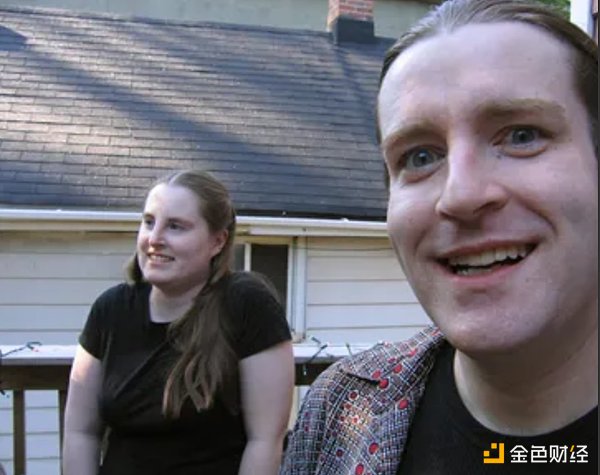 Le
Le
was a self-taught technologist even at a young age, with a penchant for cryptography and protocol development. Although he lived in a small town in Pennsylvania, at the age of 18 he joined the Internet Engineering Task Force, working on the TCP/IP protocol underlying the Internet, and later on the Bitcoin network.
“Always a little weird because he was smart,” Len was diagnosed with depression as a teenager. Unfortunately, he suffered trauma at the hands of a “borderline sadistic” psychiatrist, an experience that can make one distrust so-called authority figures.
In 1999, Len moved to the Bay Area and quickly became a fixture in the Cypherpunk community. He roomed with Bram Cohen, the founder of Mojo and Bittorrent, and became a contributor to the legendary Cypherpunk mailing list, where Satoshi first announced Bitcoin. Other hackers remember him as smart and lighthearted, chasing down a squirre at Cypherpunk conferences and speeding in a sports car with a "Get Out of JaiFree" card on it in case he got pulled over.
In San Francisco, Len dedicated himself to defending individual freedom and privacy through technology and political direct action. At 21, he made headlines for organizing protests against government surveillance and the jailing of hacker Dmitri Skylarov.
Early in his career, Len made a name for himself as an authority on public key cryptography, the foundation of Bitcoin. By the age of 22, he was speaking at conferences and had founded a public key cryptography startup with Bruce Perens, a well-known open source activist.
After the dot-com crash, the startup folded, and Len joined Network Associates to help develop PGP cryptography, the core of Bitcoin. During the 2001 release of PGP7, Len set up interoperability testing for the OpenPGP implementation, which brought him into contact with many important cryptographic pioneers. Len also contributed to the GNU Privacy Guard implementation of OpenPGP and worked with PGP inventor PhiZimmerman to invent a new cryptographic protocol.
In introducing Bitcoin, Satoshi Nakamoto said he hoped that Bitcoin would be able to use the same strong encryption technology (i.e. PGP) that is used to protect files as "currency".
A generation ago, multi-user time-sharing computer systems had a similar problem. Before strong encryption, users had to rely on password protection…
Then, strong encryption technology became available to the public, and trust was no longer required. …Now it’s time to do the same with currency.

At Network Associates, Len worked with HaFinney to develop PGP. Finney was the second PGP developer and helped create the RFC 4880 standard for OpenPGP interoperability. He is also the earliest and most important contributor to Bitcoin after Satoshi Nakamoto:
Finney was the first person other than Satoshi to contribute to the Bitcoin code and run a Bitcoin node.
Finney was the first recipient of Bitcoin (sent by Satoshi himself).
Finney invented the concept of Reusable Proofs of Work, on which Bitcoin mining is based.
Satoshi Nakamoto had extensive exchanges with Finney long before Bitcoin was released. In his last blog post, Satoshi publicly expressed his respect for Finney.
Not surprisingly, Finney is one of the most popular candidates for Satoshi, even though this meant that Finney faked a lot of his email interactions with Satoshi and contributed to Bitcoin under both his real name and another fake identity. Finney would continue to work on Bitcoin after Satoshi “left” in 2011.
Len and Finney had a very rare and related skill: they were both developers of the Bitcoin precursor, remailers.
Both remailers and cryptocurrencies were proposed by David Chaum, and remailers are specialized servers for sending messages anonymously or pseudonymously. Their use was very common when contributing to the Cypherpunk mailing list, which itself was built on distributed remailers.
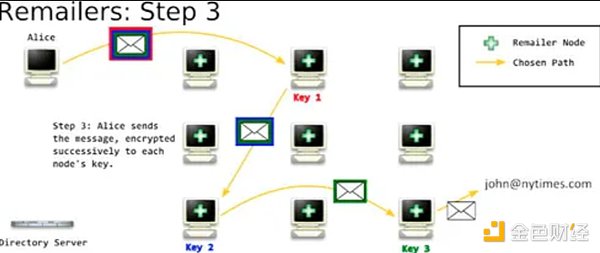
Schematic diagram of a type II mail forwarder
Early mail forwarders simply forwarded messages while hiding the identity of the sender, while later protocols (such as Mixmaster, the most popular mail forwarder) rely on decentralized nodes to distribute fixed-size encrypted blocks of information on a P2P network. Bitcoin's architecture is very similar to a mail forwarder, although its nodes transmit transaction data instead of messages. In 1997, crypto-anarchist founder Tim May even proposed a digital currency based on a mail forwarder.
As the lead developer, node operator, and lead maintainer of Mixmaster, Len is a prominent expert on mail forwarding technology. He has also implemented similar technology as a systems engineer and security architect at Anonymizer, a privacy guard.
Mail forwarding technology is not only a direct technical precursor to Bitcoin, but also fundamental to Bitcoin's intellectual history. In the article "Why We Need Mail Forwarders", Finney argues that mail forwarding technology is the foundation of an anonymous digital economy.
Mail forwarding technology represents the "bottom of the road" of this temple of ideas, the ability to exchange information privately without revealing our true identity. The way we can transact, show our credentials, and reach a deal, without a government or corporate database tracking our every move.
One of the cypherpunks' visions included the ability to transact anonymously using "digital cash"... This is another area where anonymous mail plays an important role.
Mail forwarding program operators were the first to recognize the need for cryptocurrencies: without an anonymous means of payment, mail forwarding programs had to be run out of the operator's own pocket. This created scalability issues, and meant that spam and abuse were a persistent problem. Because of this, the underlying concepts of many cryptocurrencies stem from the need for an abuse-resistant, for-profit mail forwarding program:
In 1994, Finney proposed that mail forwarding programs could be monetized through anonymous "tokens" and "cash tokens."
Smart contracts were first discussed in the context of preventing mail forwarding program abuse. Nick Szabo published a prescient paper on smart contracts in 1997, specifically mentioning Mixmaster.
Ian Goldberg and Ryan Lackey (Len knew both of them) were important figures in the mail forwarding community, and they participated in the development of an unfinished cryptocurrency called HINDE in 1998. Ian later created several early ecash clients, and Ryan became the CSO of Tezos.
So, Satoshi's second article on Bitcoin pointed out that sending emails for a fee was the first working use case of Bitcoin.
Initially it could be used for proof-of-work applications that were almost free but not quite free services.
It can already be used to send emails for a fee. The send dialog is resizable and you can enter a message of any length.
One person who crossed paths with Len in the small mail forwarding community was Blockstream CEO Adam Back, who was the first person to communicate with Satoshi.
Back's interest in cryptocurrencies began while running mail forwarding programs, and he created the HashCash proof-of-work system for mail forwarding program operators to combat spam and DDOS attacks. Satoshi later used HashCash as the basis for Bitcoin mining.
We know that Len worked directly with Back, listing him as a contributor to research papers and Mixmaster memos. Both were involved in many OpenPGP implementations and were connected in each other's PGP trust network.
Interestingly, Back himself has suggested that Satoshi may have been a mail forwarder developer, noting that developers would "[practice] their own techniques" to participate anonymously in cryptographic protocol discussions. Unlike many of the Cypherpunks discussed, we know that Len made a lot of anonymous contributions to the Cypherpunk mailing list via a mail forwarder.
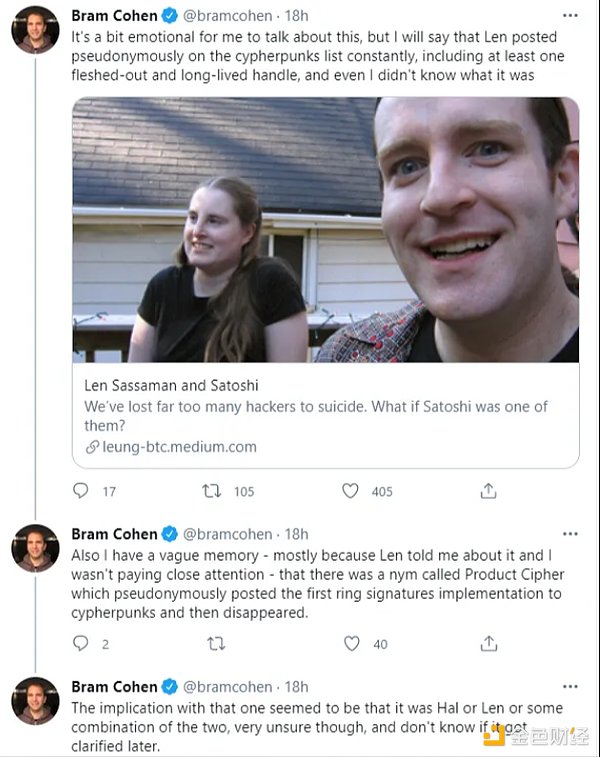
Bram Cohen responded to this article, suggesting that he and Hal Finney may have worked under pseudonyms
After graduating from high school, Len worked to support his family and never had the opportunity to go to college. Despite this, in 2004 he landed his "dream job" as a researcher and doctoral student at COSIC, a computer security and industrial cryptography research group at the Catholic University of Louvain in Belgium.

Len's doctoral advisor at COSIC was none other than David Chaum, the "Father of Digital Currency." While Chaum laid the foundation for the entire cypherpunk movement and all cryptocurrencies, few can say they have worked directly with him.
Some of Chaum's related achievements:
He invented cryptocurrency in his 1983 paper "Blind Signatures for Untraceable Payments."
Inventor of the blockchain, his 1982 paper detailed the code for all but one element of the blockchain, which are detailed in the Bitcoin whitepaper.
His company, Digicash, created the first electronic cash system. Anonymous payments between digital pseudonyms were central to this vision.
“[Chaum] was at the center of a seemingly unstoppable movement—the digitization of money… The wild card in the age of digital money is anonymity, and David Chaum believed that without it we were in trouble”
While Digicash failed (in part due to its reliance on a centralized system), Chaum hoped to create a second digital currency that would offer a combination of anonymity and utility.
While many see its failure as proof that digital cash is unviable, Satoshi defends “old Chaumian money” while acknowledging the problems that come with centralization.
Many people automatically assume that electronic money is doomed to fail because so many companies have failed since the 1990s. I hope that people understand that it is the centrally controlled nature of these systems that dooms them to failure.
Len worked at COSIC in Belgium until his death in 2011. During this time, he published 45 papers and held 20 conference committee positions.
Len’s research focused on developing privacy-enhancing protocols with “real-world applicability” and working code. His main project (assisted by Bram Cohen) was Pynchon Gate, an evolution of mail-forwarding technology that allowed anonymous information retrieval through a distributed network of nodes without the need for a trusted third party.

Pynchon Gate and the meta-index + bucket poo architecture
This work is closely related to Bitcoin - as work on Pynchon Gate progressed, Len became increasingly focused on finding solutions to Byzantine faults (aka the Byzantine Generals Problem), which had been a major obstacle to early P2P networks.
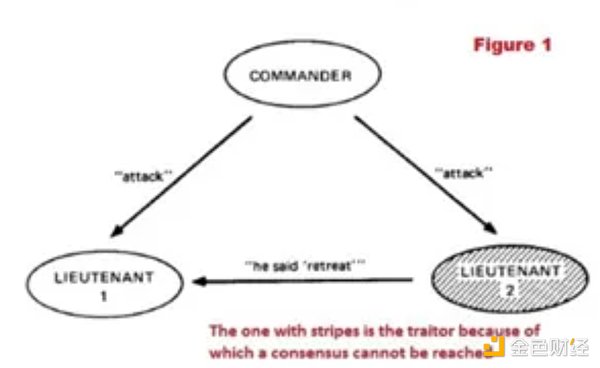
Byzantine Generals Problem Diagram
In the context of distributed computing, Byzantine fault tolerance refers to the ability of a network to remain operational even if nodes are compromised or unreliable. Byzantine faults are one of the biggest problems in implementing secure, decentralized cryptocurrencies without double payments or trusted third parties. Satoshi Nakamoto's most important innovation was the "triple-entry" accounting system, which solved this problem using the blockchain introduced by Chaum.
During the development of Bitcoin between 2008 and 2010, Len became increasingly active in the field of financial cryptography. He joined the International Financial Cryptography Association and gave presentations at and served on committees at the Financial Cryptography and Data Conference. The latter was founded by Robert Hettinga, an early and prominent advocate of digital cash, which was a major topic at the conference.
Nakamoto was working in academia during the development of Bitcoin, an idea shared by Gavin Andersen, founder of the Bitcoin Foundation.
"I think he's an academic, maybe a postdoc, maybe a professor, who just doesn't want to draw attention."
Nakamoto's code contributions and comments increase dramatically during the summer and winter vacations, but taper off in late spring and year-end, when academics take final exams or get graded.
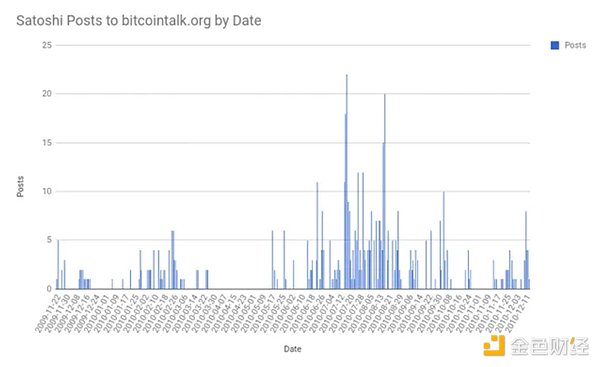
The unique structure of the Bitcoin code also suggests that Nakamoto has an academic background. Bitcoin has been described as “brilliant but careless,” eschewing traditional software development practices like unit testing but exhibiting cutting-edge security architecture and an expert understanding of academic cryptography and economics.
Whoever did it had a deep understanding of cryptography… they had read academic papers, they had a sharp intellect, and they brought those concepts together in a truly new way.
When renowned security researcher Dan Kaminsky first reviewed Satoshi’s code, he tried to penetrate it with nine different vulnerabilities but was surprised to find that Satoshi had anticipated and patched them all.
“I thought of some beautiful bug, but every time I looked at the code I found a line of code that would fix the problem… I’d never seen anything like it.”
This may indicate that Satoshi and Kaminsky had shared information security experience and expertise. Coincidentally, Len and Kaminsky co-authored and published a paper demonstrating methods for attacking public key infrastructure.
In addition, the Bitcoin whitepaper was published in a format rarely seen on the Cypherpunk mailing list—a LaTeX-formatted research paper with academic content such as an abstract, conclusion, and MLA citations. In contrast, other proposals such as Bitgold and b-money were unstructured blog posts.
Since COSIC is headquartered in Leuven, Len lived in Belgium during the development of Bitcoin. This is significant because many facts indicate that Satoshi lived in Europe—a major focus of the New Yorker’s early investigations.
Satoshi’s writing style reflects British English spelling and vocabulary choices, such as “bloody hard,” “flat,” “maths,” “grey,” and the dd/mm/yyyy date format. However, Satoshi also mentioned the Euro instead of the Pound.
The genesis block of Bitcoin also contains a headline from that day's edition of The Times ("The Times 03/Jan/2009 Chancellor on brink of second bailout for banks"). This headline is specific to the print edition, which is only distributed in the UK and Europe. In 2009, The Times was one of the top ten newspapers in Belgium and was "widely used by academics and researchers due to its wide circulation in libraries and its detailed indexing".

These clues leave us with a paradox: they suggest that Satoshi was European, but the person who possessed the necessary skills and understood the main implications of Bitcoin was most likely an American. Most of the cypherpunk community united for conferences and meetups, which is one reason why there is a disproportionate number of people from the United States, especially San Francisco. Similarly, jobs where you can get cutting-edge professional information security and cryptography experience are concentrated in the United States.
Oddly, despite being an American, Len uses exactly the same British English as Satoshi.
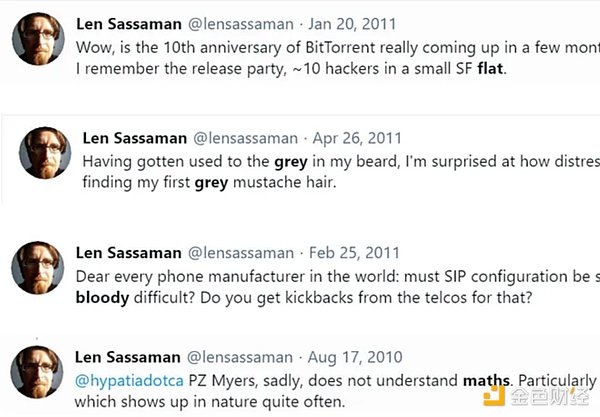
Analyzing Satoshi’s posting history, it can be found that he is a European "night owl" who works on Bitcoin after get off work or school during the day. Satoshi also said that the increase in mining difficulty occurred "yesterday", but if he lived in the United States, the situation would be different.
Assuming Satoshi led a life unrelated to Bitcoin, he was not at his computer at home most of the time while working or studying... If Satoshi lived in the BST time zone, he worked most of the time at night, often until the early hours of the morning
When we checked Len’s tweet history, we found that the timestamps of Satoshi’s posts and code commits matched closely with Len’s own late-night activity.
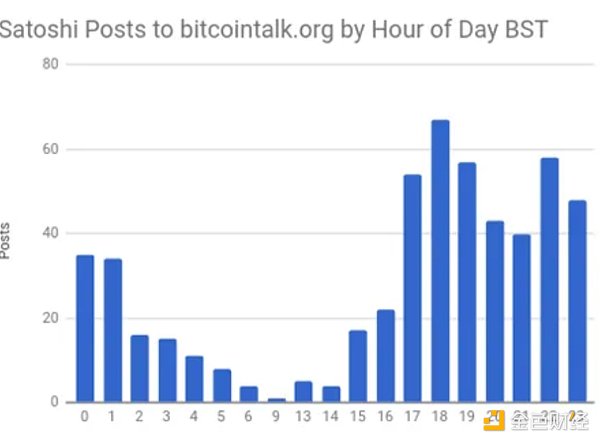
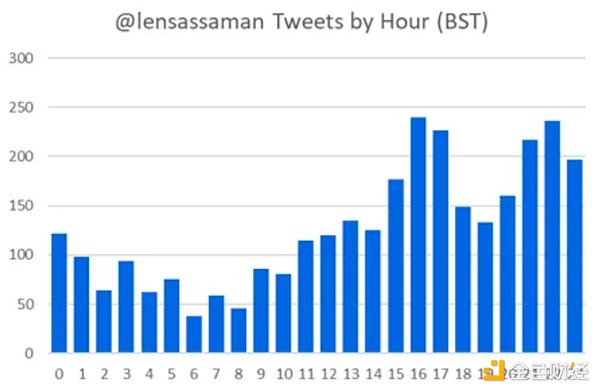
I have been working on a new electronic cash system that is completely peer-to-peer and does not require a trusted third party
Dan Kaminsky said that in order to create Bitcoin, Satoshi Nakamoto needed to "understand economics, cryptography, and P2P networks," and Len had an unusually early and in-depth understanding of these three disciplines and their application to digital currencies.

Bram and Len interviewed at CodeCon
While in San Francisco, Len lived and worked with Bram Cohen, the creator of the most widely used P2P protocol BitTorrent. During this time (2000-2002), Bram developed a revolutionary P2P network called MojoNation, which used the "Mojo Token" digital currency, making it one of the first publicly issued digital currencies.

In MojoNation’s P2P economy, “tokens” can be redeemed for file storage, which will be encrypted and encoded into “blocks” uploaded to a distributed network of nodes hosting a public ledger, reminiscent of Bitcoin’s own distributed bilateral accounting system. Mojo is not just an internal accounting token, but a full currency - it can be redeemed for US dollars and vice versa. Some of the early discussions of token economics involved the mechanics of the Mojo token.
One unit of Mojo represents a portion of the current functionality of the entire system. If you work for me now, I will give you points, and in the future when the network is larger, these points will represent a piece of a larger pie, so their value will increase when you spend them.
Satoshi discussed token economics in a very similar way, referencing BitTorrent
For transferable proof-of-work tokens to have value, they must have monetary value. To have monetary value, they must be transferred across a very large network — such as a file trading network similar to BitTorrent.
Despite its foresight, MojoNation's economy soon collapsed due to hyperinflation. Satoshi consciously designed Bitcoin to avoid this fate by having deflation built in and not relying on a central "coining" server.

In 2001, Bram launched BitTorrent. As a P2P alternative to centralized Napster, BitTorrent foreshadowed Bitcoin's own distributed node topology and consensus system, as well as a protocol-level incentive system. BitTorrent not only innovated networks such as Gnutella at the technical level, but also utilized economic incentives and game theory.
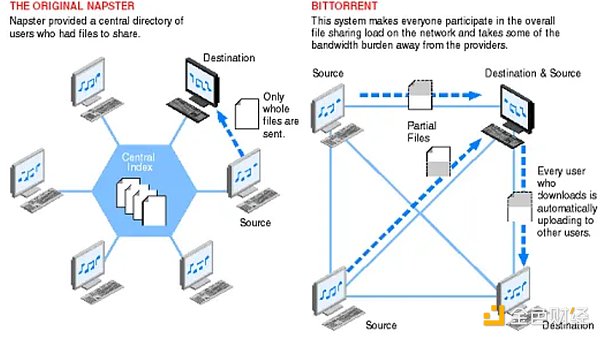
Bittorent’s design compared to Napster
Len presciently told Bram that “BitTorrent will make him greater than [Napster founder] Sean Fanning.” Satoshi later mentioned Napster when explaining the need for a fully decentralized web.
Governments are good at cutting off the leadership of centrally controlled networks like Napster, but pure P2P networks like Gnutella and Tor seem to be able to hold their own.
Coincidentally, Len and Tor founder Roger Dingledine both participated in the development of the Mixminion mail forwarding protocol, spoke together at the Black Hat conference, and co-founded the HotPETS conference.
In 2002, Len and Bram co-founded the CodeCon conference, which focuses on "highly practical projects with useful code." At CodeCon in 2005, Finney introduced reusable proof of work through a modified BitTorrent client that sent P2P digital currency. One commentator described it as:
...the world's first transparent server, which facilitates a distributed, collaborative world of RPOW servers.
Cryptocurrencies were a hot topic at the inaugural CodeCon, which included a HashCash demo by Adam Back and Zooko's introduction of Mnet, the fully open source and decentralized successor to MojoNation. Mojo is not affiliated with any one company and can be independently audited, both of which Satoshi considered critical.

Mnet client screenshot
MojoNation co-founders Zooko Wilcox and Jim McCoy also became inspirations for Bitcoin and cryptocurrency pioneers. Zooko was one of Satoshi's first collaborators and an employee of David Chaum of Digicash. When releasing Bitcoin v0.1 on Bitcoin.org, Satoshi attached a link to Zooko's blog. Zooko later founded the major privacy-focused cryptocurrency Zcash. He created the often-discussed "Zooko Impossible Triangle" framework.
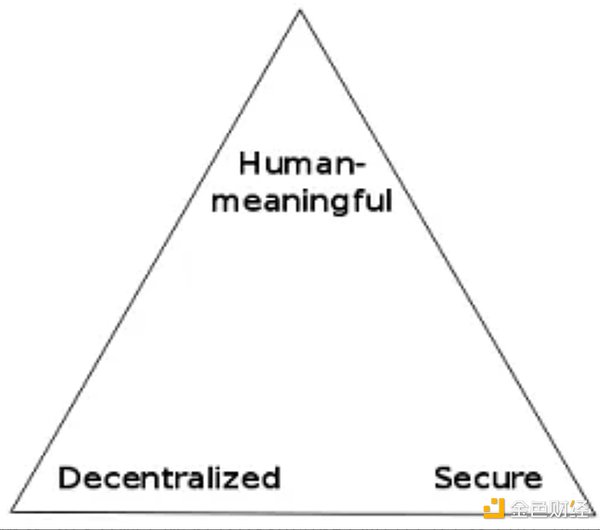
"Zooko Impossible Triangle is a trilemma of three properties that names of participants in a network protocol are often thought to have"
McCoy is also a major influencer in the cryptocurrency space, and Ryan Selkis of DigitaCurrency Group said he believes McCoy may be Satoshi Nakamoto.
Even by the standards of the cypherpunk community, both Len and Satoshi had particularly strong ideological convictions and commitments to open knowledge.
I wish you would stop talking about me… maybe talk about open source projects and give more credit to your development contributors
Satoshi’s “hacktivist” approach to distributing Bitcoin through free, open source grassroots projects stands in stark contrast to their predecessors. Chaum, Stefan Brand, eCash, and others took a very different approach: filing patents, forming closed source venture capital firms, and trying to drive adoption through corporate partnerships.
This parallels Len’s extensive contributions to open source projects like PGP, Mixmaster, GNU Privacy Guard, and his extensive volunteer experience in groups like the Shmoo Group.

In response to this story, Bram said Len prefers to publish anonymously
Nakamoto has repeatedly hinted at his ideological leanings, saying that Bitcoin is "very attractive to libertarian views" and can "win a major battle in the arms race and gain a new free territory in a few years."
Len is equally passionate about defending open knowledge and technological progress from interference from corporations and governments.
The pursuit of knowledge is a fundamental part of being human. Any kind of prior restriction is, in my view, an infringement on our freedom of thought and consciousness. So not only do I hope we can avoid overly restrictive knee-jerk legislation… I don’t want to see anyone build a framework that could be misused for that purpose.
Just as Satoshi created Bitcoin under a pseudonym, Len was in a sense forced to live under his role. After his accident in 2006, Len’s non-epileptic seizures and increasingly functional neurological problems exacerbated the depression he had been battling since his youth.
As a victim, Len “felt like he had to continue to maintain the illusion that he was this super-capable guy” and was “terrified” that his declining health would end his work and disappoint the people he cared about.
Despite these challenges, Len continued to work until a few months before his death, contributing to papers and even giving a speech at Dartmouth. Tragically, he successfully hid the severity of his situation from almost everyone in his life.
Few people knew the extent of it… One thing I heard repeatedly was “we never knew, it looked like he was doing fine”.

Len speaking at Dartmouth shortly before his death
Just as Len built on the ideas that came before him, one sensed that he was committed to building something that would outlast him, which is one of the reasons he was so committed to open source and open knowledge.
This is our legacy, our research and ideas, which will lead to knowledge that humans in history have never had the opportunity to obtain, and which we will pass on to future generations. We need to make sure we don’t get stuck with not being able to share our research with others, that it doesn’t get locked away in the vaults of IP lawyers.
Len’s death in 2011 was a huge loss for the cypherpunks and the tech community at large, a fact reflected in the outpouring of memories and sympathies that followed. One comment that stuck out to me was a post on Hacker News by “pablos08”:
Len and I became friends as co-participants in the cypherpunks back in the wild frontier. We reimagined our world, a world filled with cryptographic systems that would mathematically enforce the freedoms we cherished. Anonymous mail forwarders would protect speech from retaliation; The Onion Router would ensure that no one could censor the internet; digital cash would enable a completely free economy. We had plans to decentralize and distribute everything.
We imagine complex and esoteric threats to future problems - and we design future protocols to defend against those threats. All of this is geeky utopian academic exercise. I prefer to keep it that way, but Len wants to get hands-on.
Cypherpunks write code.
HBO documentary reignites speculation that Len Sassaman is the creator of Bitcoin. I know Len. This theory makes sense.
 JinseFinance
JinseFinance"A long-dormant Bitcoin whale, active during the earliest days of the Bitcoin network, has recently resurfaced, moving millions in Bitcoin according to blockchain data firm Arkham Intelligence.
 XingChi
XingChiRecently, there have been rumors in the community that the HBO documentary that will premiere next week may reveal the true identity of Satoshi Nakamoto, the creator of Bitcoin.
 JinseFinance
JinseFinanceBingX reports a minor asset loss following suspicious outflows, with security firms suggesting larger potential losses. The exchange has paused withdrawals as it investigates.
 Dante
DanteAdvantages and challenges of Solana Actions & Blinks vs. Ethereum Farcaster & Lens.
 JinseFinance
JinseFinanceThe ETH you pledge will become the coveted meat of Blast ecological projects.
 JinseFinance
JinseFinanceThrough three rounds of RetroPGF, Optimism has funded many start-up projects and continued to inject blood into many existing projects. It is the furthest project in the field of public goods funding.
 JinseFinance
JinseFinanceOnce the dream of getting rich is ignited in your heart, the more likely outcome is that you become so anxious that you sacrifice your own capital for others to achieve the goal of 100 million dollars.
 JinseFinance
JinseFinanceDelve into the ripple effects caused by the untimely death of Yoozoo Networks CEO Lin Qi, touching on the upcoming court case, internal power shifts, and the company's uncertain financial future. It also explores new strategic directions taken by Yoozoo in an attempt to stabilise its position in the gaming industry.
 YouQuan
YouQuanAave will enable content creators to "own their digital roots" and call for a more sustainable smart contract-based social experience.
 Cointelegraph
Cointelegraph